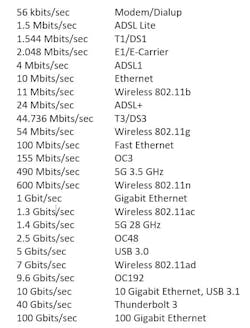Bandwidth vs. speed
By Albany Zeno, MNJ Technologies
One key area of concern that I often notice when vetting and designing a customer’s solution is the lack of attention that is given to the bandwidth that is actually needed to transmit their data, run their apps, etc. Oftentimes the estimated bandwidth needed is severely underestimated and being miscalculated with speed or “throughput” estimates vs. bandwidth needs.
Think of it this way: When you are sitting in a 6-lane traffic jam on the highway going 10 miles per hour in a car that can do over 100 miles per hour, the problem is not the car. The problem, at this particular time, is the number of lanes that are being used, or blocked at the peak time in which most people are trying to use it. The car’s ability to go 100+ miles per hour in this scenario is the speed, whereas the highway and lanes on which the car travels is the bandwidth. So, when thinking of a solution, are you OK with traffic jams during peak times that can result in jitter, latency, packet loss, etc.? Or would you determine if an 8-lane highway is more suitable?
When planning how much bandwidth is enough, you would need to take into account the number of users, number of devices, size of your office or home, intended usage, current/future network maximum capabilities of throughput, in addition to deciding which is most important—figuring which device will deliver the data the cheapest (per unit or per Mbit/sec), or getting my data there efficiently.
Check and compare manufacturers’ throughput allowance when designing your network. The most expensive of best-known brand is not always the best performing.
Security parameters or protocols will eat into your speed, much like if the car you are driving on an open freeway must go through a carwash every five miles. In this scenario, your time getting from Point A to Point B would be delayed.
Normal digital footprint for speed in the data ecosystem is about 12 to 19 Mbits/sec per user, and if you are working with 4K streaming it jumps to 25 to 39 Mbits/sec per user. Factor in your peak times with usage estimates and see where you fall. Additional considerations to make: As you transition to more artificial intelligence (AI) and automation, how will that consume your network capabilities?
There are many different highway types to choose from, e.g. WiFi, LAN, 4G, 5G, WAN, SD-WAN, etc. Each type has a limit based on the manufacturer throughput allowance (going 35 mph vs. 70 mph).
Here are speeds you can expect. (Speeds are only peak speed recordings. You will never achieve these numbers during normal use due to overhead and other network factors.)Albany Zeno is vice president of services with MNJ Technologies, a managed service provider based in Buffalo Grove, IL.

